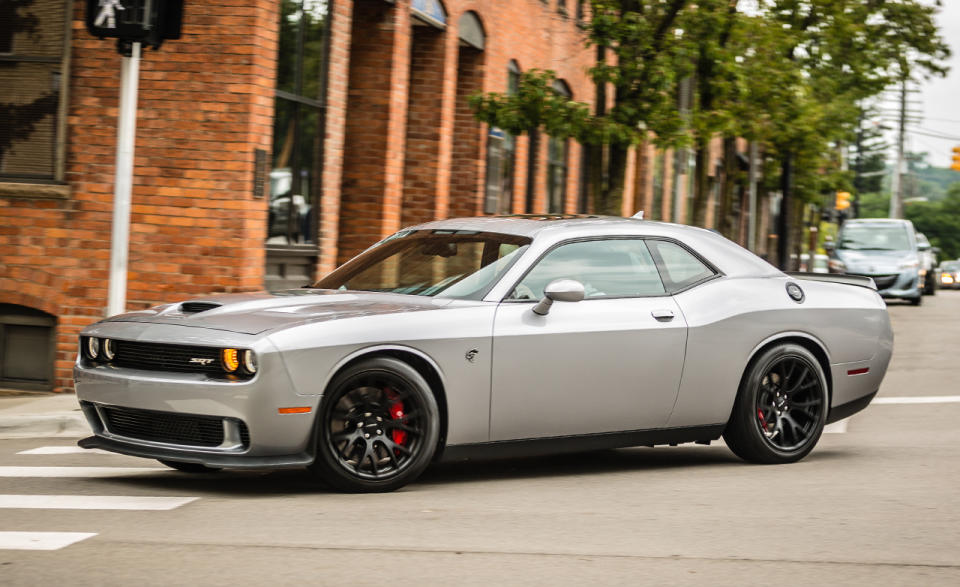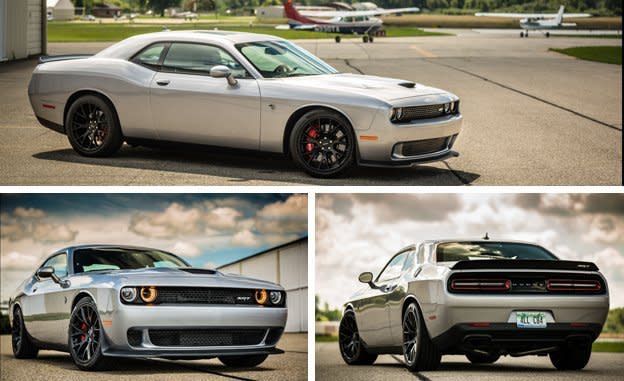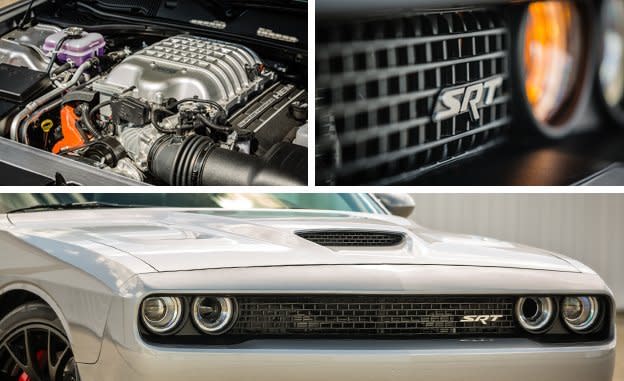2016 Dodge Challenger SRT Hellcat Automatic

Attentive readers will know that we have already put not one, but two 2015 Dodge Challenger SRT Hellcats through our typical barrage of tests—one equipped with a six-speed manual transmission, the other an eight-speed automatic. For its second model year, Dodge left the powertrains untouched. This Challenger’s blown 6.2-liter V-8 still pushes the same tire-smoking 707 horsepower and 650 lb-ft of torque to the rear wheels. Our test car had the optional ($2995) eight-speed automatic that can swap ratios in as little as 160 milliseconds. So why put this essentially unchanged, approximately two-and-a-quarter-ton beast through our tests again? To quote technical editor K.C. Colwell, “Because it’s a Hellcat.”
And because it’s a Hellcat, our Billet Silver Metallic test car attempted to make mincemeat of its rear tires at every opportunity. Seriously, this is a difficult car to launch on a sticky drag strip, let alone the public-road-like conditions on which we test. Its launch traction is easily overwhelmed by the engine’s massive amount of torque, despite our test car’s sinister-looking 14-spoke, 20-inch wheels being wrapped in a set of sticky 275/40 Pirelli P Zero summer tires, a $695 option. Good luck trying to launch a Hellcat riding on the standard all-season rubber. (Next year’s wide-body Hellcat ADR should pack more meat in its wheel wells.)

But if you tickle the throttle just right, the Hellcat delivers seriously heroic acceleration, much quicker than can be achieved with its built-in launch-control feature. Zero to 60 mph happens in 3.6 seconds, 100 mph comes up in 7.8 seconds, and the quarter-mile is covered in 11.7 seconds at 126 mph, with the car’s massive supercharger whining like a hive of angry bees the entire time. Those are the same times that we recorded for the 2015 edition with the automatic transmission, although 100 mph took 0.2 second longer this time. Balancing the torque against the available traction is never quite exactly the same experience twice.
Although standing-start acceleration runs in the Hellcat are breathtaking, the real eye-widening happens once it’s rolling. Top-gear acceleration from 30 to 50 mph and from 50 to 70 mph happens in 1.8 and 2.3 seconds. Passing other traffic poses no worries beyond avoiding the attention of the local constabulary. Booting the gas pedal at anything less than triple-digit speeds goes something like this: The big coupe squats back, the transmission quickly kicks down to a lower gear, and the car rockets forward, its rear tires slipping and fighting to maintain contact with the road. Don’t get behind in your steering.
A tamer Hellcat experience can be found within the “SRT Performance Pages” of the car’s standard 8.4-inch Uconnect touchscreen infotainment system. Here, owners can adjust the Hellcat’s dampers, traction control, shifting, and horsepower settings. The latter function offers options to keep the stable doors open and let all 707 horses run free or to corral 207 of those ponies. The same settings can be accessed by swapping between the Hellcat’s red and black proximity keys—the former defaults to the high-horsepower mode and the latter to the less-powerful option. Either way, the Hellcat remains a handful. If the goal of the lower-horsepower setting was to give Hellcat owners a more civil driving experience, then Dodge failed—in a good way. Our advice: If you’re just going to drive with the black key more than every so often, consider the less pricey 485-hp Challenger SRT 392 or the even more affordable R/T Scat Pack with the same 485-hp V-8. You’d give up the supercharger whine and a half-second to 60 mph, but you also won’t feel like every drive is an exercise in pulling back on the reins and shouting “whoa!”

While the horsepower may leave the impression that Dodge has created a one-trick pony car, all about epic straight-line pulls, the two-door proves to be a decent partner on winding roads, so long as you keep the pace a few notches below full out. You’d not expect so, seeing that the 6.2’s iron block contributes to putting nearly 57 percent of the Hellcat’s 4493-pound curb weight on its front wheels. But the Hellcat’s well-sorted suspension and quick and relatively talkative steering rack (2.5 turns lock-to-lock) keep you in control during cornering. Both the suspension and steering can be adjusted between Street, Sport, and Track settings within the SRT Performance pages to suit conditions and your driving style. Prepare for the chatty steering to tell your hands “I’m out of grip!” when you push hard, though, and be judicious with the throttle when exiting a corner. The Hellcat’s skidpad performance of 0.92 g is nothing to scoff at, but both our long-term Ford Mustang GT and Chevrolet Camaro SS posted better figures (0.94 g and 0.98 g) and we expect the forthcoming Mustang Shelby GT500 and Camaro ZL1 will generate even more lateral grip, in no small part because they’re lighter cars.
Thankfully, when the Hellcat’s tires lose traction, they tend to do so predictably. Oversteer can generally be turned into a controlled drift, provided, once again, you don’t boot the throttle too heavily, while understeer can be quelled with a tap of the Hellcat’s big binders. The traction- and stability-control systems, which can be fully defeated for track play, also assist in keeping the Hellcat in check on the road.
Measuring 15.4 inches up front and 13.8 inches in the rear, the Hellcat’s vented and slotted brake rotors are gripped by meaty six- and four-piston Brembo calipers. From 70 mph, the hefty Challenger SRT Hellcat came to a stop in only 159 feet. That’s impressive—and in the neighborhood of the 150- and 156-foot stops we recorded in our long-term Camaro and Mustang.
Inside, comfortable seats, a modern infotainment system, and a decent ride quality make for an agreeable day-to-day partner. Tall drivers should avoid the sunroof option ($995), as it robs too much headroom. (For the record, this car weighed five pounds more than the 2015 automatic car without the sunroof.) Save that money to feed the car a steady diet of premium fuel. In our hands, the Hellcat sucked down a gallon every 13 miles. (We’ve previously established that repeated quarter-mile runs can drain the tank at a 4 mpg rate.) The EPA rates this automatic transmission version at 13 mpg in the city, 22 on the highway. With the standard six-speed manual transmission, the highway rating drops to 21 mpg. All Challenger SRT Hellcats are slapped with a $1700 gas-guzzler tax.

Dodge also tacked on an additional $5200 to the automatic Hellcat’s base price for 2016 (and $4300 for the stick-shift car), more or less keeping for itself the extra profit that dealers had been adding to the price on 2015 models, which some buyers were willing to pay for the honor of being a Hellcat early adopter. Offsetting the sticker-price bump, the 2016 car comes with a standard navigation system and can be equipped with full-leather seats at no cost, two popular items that combined to add $2490 to 2015 editions. This new model year also brings additional functions to the Uconnect infotainment system, including drag-and-drop customization of the menu bar. Optional center stripes with a faux carbon-fiber pattern and an available Go Mango orange paint scheme are new, too. Our test car rang in at $70,775 with the automatic transmission, sunroof, and summer tires.
Yes, the 2016 Dodge Challenger SRT Hellcat is far more car with far more power than any mere mortal will ever need. So why would anyone consider this car? Because it’s a Hellcat.
Specifications >
VEHICLE TYPE: front-engine, rear-wheel-drive, 5-passenger, 2-door coupe
PRICE AS TESTED: $70,775 (base price: $62,495)
ENGINE TYPE: supercharged and intercooled pushrod 16-valve V-8, iron block and aluminum heads, port fuel injection
Displacement: 370 cu in, 6166 cc
Power: 707 hp @ 6000 rpm
Torque: 650 lb-ft @ 4000 rpm
TRANSMISSION: 8-speed automatic with manual shifting mode
DIMENSIONS:
Wheelbase: 116.2 in
Length: 197.5 in
Width: 75.7 in Height: 55.7 in
Passenger volume: 94 cu ft
Cargo volume: 16 cu ft
Curb weight: 4493 lb
C/D TEST RESULTS:
Zero to 60 mph: 3.6 sec
Zero to 100 mph: 7.8 sec
Zero to 130 mph: 12.8 sec
Zero to 150 mph: 17.3 sec
Rolling start, 5–60 mph: 4.1 sec
Top gear, 30–50 mph: 1.8 sec
Top gear, 50–70 mph: 2.3 sec
Standing ¼-mile: 11.7 sec @ 126 mph
Top speed (drag limited, mfr's claim): 199 mph
Braking, 70–0 mph: 159 ft
Roadholding, 300-ft-dia skidpad: 0.92 g
FUEL ECONOMY:
EPA city/highway driving: 13/22 mpg
C/D observed: 13 mpg

 Yahoo Autos
Yahoo Autos 